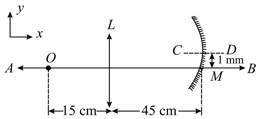A hollow sphere of glass of R.I. has a small mark on its interior surface is observed by an observer from a point outside the sphere. is centre of the sphere. The inner cavity (air) is concentric with the external surface and thickness of the glass is every where equal to the radius of the inner surface. Find the distance by which the mark will nearer than it really is in terms of and assuming paraxial rays.
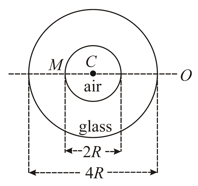


Important Questions on Ray Optics
In the figure shown, find the relative speed of approach/separation of the two final images formed after the light rays pass through the lens, at the moment when . The speed of object . The two lens halves are placed symmetrically w.r.t. the moving object.
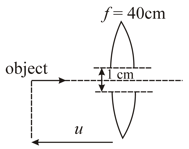
The figure illustrates an aligned system consisting of three thin lenses. The system is located in air. Determine (a) the position (relative to right most lens) of the point of convergence of a parallel ray incoming from the left after passing through the system (b) The distance between the first lens and a point lying on the axis to the left of the system, at which that point and its image are located symmetrically with respect to the lens system?
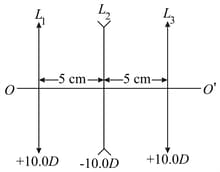
A right angle prism of refractive index has a plane of refractive index cemented to its diagonal face. The assembly is in air. The ray is incident on .
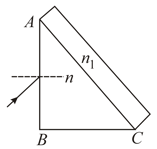
(i) Calculate the angle of incidence at for which the ray strikes the diagonal face at the critical angle.
(ii) Assuming , calculate the angle of incidence at for which the refracted ray passes through the diagonal face undeviated. ()
A glass wedge with a small angle of refraction is placed at a certain distance from a converging lens with a focal length , one surface of the wedge being perpendicular to the optical axis of the lens. A point sources of light is one the other side of the lens at its focus. The rays reflected from the wedge (not from base) produce, after refraction in the lens, two images of the source displaced with respect to each other by . Find the refractive index of the wedge glass. [Consider only paraxial rays].
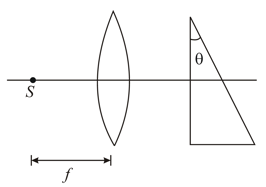
A log solid cylindrical glass rod of refractive index is immersed in a liquid of refractive index . The ends of the rod are perpendicular to the central axis of the rod. A light enters one end of the rod at the central axis as shown in the figure. A light enters one end of the rod at the central axis as shown in the figure. Find the maximum value of angle for which total internal reflection occurs inside the rod?
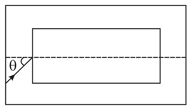
In the figure shown is converging lens of focal length and is a concave mirror of radius of curvature . A point object is placed in front of the lens at a distance . and are optical axes of the lens and mirror respectively. Find the coordinates of the final image formed by this system taking as origin. The distance between & is .
